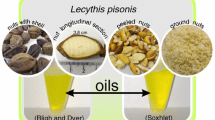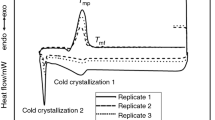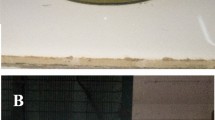Abstract
The Pracaxi oil—(Pentaclethra macroloba) contains high concentrations of fatty acids with emollient action that contribute to skin hydration. The use of this oil is supported by the utilization of natural resources thus enabling regional development and social contribution. The objective of this study was to characterize the P. macroloba oil by thermogravimetry (TG, DTG, and DTA), gas chromatography, Fourier transform infrared spectroscopy (FT-IR), and oxidation stability—Rancimat, aiming at the quality control of plant raw material. Three samples of crude oil sold by Amazon Oil Industry (Ananindeua, Pará, Brazil) were studied. The analysis of these oil samples showed different fatty acids, especially the behenic, oleic, linoleic, and lignoceric acids totalizing approximately 96 % of the grease composition and in smaller percentage arachidic, lauric, myristic, palmitic, and linolenic acids were found. The major acids have wide medicinal use. According to the TG/DTG curve, thermal stability was observed up to 220 °C, indicating a greater mass loss related to the dehydration and elimination of volatile substances. The thermal decomposition process occurred in the range of 430–450° C according to the DTG curve. The absorption spectrum in the infrared region (FT-IR) showed well-defined bands confirming the presence of functional groups present in the oil. Tests in a Rancimat have shown an induction period between 8 and 10 h demonstrating that the samples are in agreement with the standards required by ANP No. 14/2012 which requires at least 6 h of testing.





Similar content being viewed by others
References
Ferreira ES, Silveira, CS, Lucien, VG, Amaral AS. Caracterização físico-química da amêndoa, torta e compostos dos ácidos graxos majoritários do óleo bruto da Castanha do Brasil (Bertholletia excelsa HBK). Alim Nutr Araraquara. 2006;17(2):203–8.
Glória MM, Regitano-D’arce MAB. Concentrado e isolado protéico de torta de castanha do Pará: obtenção e caracterização química e funcional. Ciên Technol Aliment. 2000;20(2):240–5.
Freitas SP, Miranda IC, Coelho MAZ. Extração e fracionamento simultâneo do óleo da Castanha do Brasil com etanol. Ciênc Technol Aliment. 2007;27(suppl):14–7.
Nascimento RJS, Couri S, Antoniassi R, Freitas SP. Composição em ácidos graxos da polpa de açaí extraído com enzimas e com hexano. Rev Bras Frutifera. 2008;30(2):32–6.
Leguminosas da Amazônia-Lista Prévia-Acta bot. bras. 1989;2(1):193–237.
Raven PH, Evert RF, Eichhorn S. Biologia Vegetal. 7a ed. Rio de Janeiro:Guanabara Koogan; 2007.
Lorenzi H. Árvores Brasileiras. vol. 2, 2a edição. Nova Odessa:Instituto Plantarum; 2002.
Chun J, Goodman CL, Rice WC, McIntosh AH, Chippendale GM, Schubert KR. Pentaclethra macroloba seed effect on larval growth cell viability and miggut enzyme activity of Helicoverpa zea. J Econ Entomol. 1994;87(6):1754–60.
Rathburn, HB. Trypsin inhibitor protein from Pentaclethra macroloba having insecticidal properties. International Patent Publication Number: Wo 9719109; 1997.
Lago RCA. Chemical composition of paraocaxi and andiroba oils. Bol Tec Cent Agric Technol Agric Aliment. 1980;14:1–16.
Da Silva JO, Fernandes RS, Ticli FK, Oliveira CZ, Mazzi MV, Franco JJ, Giuliatti S, Pereira OS, Soares AM, Sampaio SV. Triterpenoid saponins, new metalloprotease snake venom inhibitors isolated from Pentaclethra macroloba. Toxicon. 2007;50(2):283–91.
Santiago GMP, Viana FA, Pessoa ODL, Santos RP, Pauliquen YBM, Arriaga AMC, Andrade-Neto M, Braz-Filho R. Avaliação da atividade larvicida de saponinas triterpênicas isoladas de Pentaclethra macroloba (Willd.) Kuntze (Fabaceae) e Cordia piauhiensis Fresen (Boraginaceae) sobre Aedes aegypti. Brazilian. J Pharmacogn. 2005;15(3):187–90.
Da Silva JO, Coppede JS, Fernandes VC, Sant’Ana CD, Ticli FK, Mazzi MV, Giglio JR, Pereira PS, Soares AM, Sampaio SV. Antihemorrhagic, antinucleolytic and other antiophidian properties of the aqueous extract from Pentaclethra macroloba. J Ethnopharmacol. 2005;100:145–52.
Freire RMM, Santos RC, Lima LM, Costa BJ, Zagonel GF. Amendoim: da mesa ao biodiesel. Embrapa Algodão—Folderes/Folhetos/Cartilhas (INFOTECA-E). Campina Grande—PB; 2010.
Novello D, Franceschini P, Quintiliano DA. A importância dos ácidos graxos omega 3 e omega 6 para a prevenção de doenças e na saúde humana. Rev Salus-Guarapuava-PR. 2008;2(1):45–54.
Baby AR, Maciel COM, Santos IMNS, Dias TCS, Kaneko TM, Consiglieri VO, Velasco MVR. Uso de extratos de plantas em produtos cosméticos. Cosmet Toilet. 2005;17(1):78–82.
Veiga-Junior VF, Pinto AC. Plantas medicinais: Cura segura? Rev Quím Nova. 2005;28(3):519–28.
Fonseca MM, Yoshida MI. Análise térmica do óleo de linhaça natural e oxidado. Vértices. 2009;11(3):61–75.
Alves TGV, Tavares EJM, Aouada FA, Negrão CAB, Oliveira MEC, Duarte Junior AP, Da Costa CEF, Silva Junior JOC, Ribeiro Costa RM. Thermal analysis characterization of PAAm-co MC hydrogels. J Therm Anal Calorim. 2011;106:717–24.
Costa RS, Negrão CAB, Camelo SRP, Ribeiro Costa RM, Barbosa WLR, Da Costa CEF, Silva Junior JOC. Investigation of thermal behavior of Heliotropium indicum L. lyophilized extract by TG and DSC. J Therm Anal Calorim. 2011;91(2):434–7.
Costa RS, Camelo SRP, Ribeiro-Costa RM, Barbosa WLR, Vasconcelos F, Silva Junior JOC. Physical, chemical and physical-chemical control of Heliotropium indicum Linn., boraginaceae, powder and tinture. IJPSR. 2011;2(8):2211–6.
Garcia CC, Franco PIBM, Zuppa TO, Antoniosi Filho NR, Leles MIG. Thermal stability studies of some Cerrado plant oils. J Therm Anal Calorim. 2007;87(3):645–8.
Ferrari RA, Souza WL. Avaliação da estabilidade oxidativa de biodiesel de óleo de girassol com antioxidantes. Rev Quím Nova. 2009;32(1):106–11.
Veiga-Junior VF, Patitucci ML, Pinto AC. Controle de autenticidade de óleos de copaíba comerciais por cromatografia gasosa de alta resolução. Rev Quím Nova. 1997;20(6):72–8.
American Oil Chemists Society. Official methods and recommended practices of the American Oil Chemists Society. 4th ed. Champaign: A.O.C.S. Official Method Ce 1-62; 1995.
American Oil Chemists Society. Official methods and recommended practices of the American Oil Chemists Society. 4th ed. Champaign: A.O.C.S. Official Method Ce 2-66; 1995.
Alves OL. Espectroscopia no Infravermelho com Transformada de Fourier: Feliz Combinação de Velhos Conhecimentos de Óptica, Matemática e Informática. Laboratório de Química do Estado Sólido (LQES). Instituto de Química. UNICAMP. Disponível em:<http:\\lqes.iqm.unicamp.br>. Acesso em: 02 Nov. 2012.
Takemoto E, Okada IA, Garbelloti ML,Tavares M, Aued-Pimentel S. Composição química da semente e do óleo de baru Dipterys olata Vog. Nativo do município de Pirenopólis, estado de Goiás. Revista Adolfo Lutz. 2001;60(2):89–97.
Organização Pan-Americana da Saúde (OPAS). Higiene dos Alimentos—Textos Básicos/Agência Nacional de Vigilância Sanitária; Food and Agriculture Organization of the United Nations: Brasília; 2006.
Albuquerque MLS, Guedes I, Alcântara P Jr, Moreira SGC. Infrared absorption spectra of Buriti (Mauritia flexuosa L.) oil. Vib Spectrosc. 2003;33:127–31.
Stuart BH. Infrared spectroscopy: fundamentals and applications. Hoboken: Wiley; 2005.
Pimentel MF, Ribeiro GMGS, Cruz RS, Stragevitch L, Pacheco Filho JGA, Teixeira LSG. Determination of biodiesel content when blended with mineral diesel fuel using infrared spectroscopy and multivariate calibration. Microchem J. 2006;82:201–6.
Oliveira JS, Montalvão R, Daher L, Suarez PAZ, Rubim JC. Determination of methyl ester contents in biodiesel blends by FTIR–ATR and FTNIR spectroscopies. Talanta. 2006;69:1278–84.
Aliske MA, Zagonel GF, Costa BJ, Veiga W, Saul CK. Measurement of biodiesel concentration in a diesel oil mixture. Fuel. 2007;86:1461–4.
Sherazi STH, Kandhro A, Mahesar AS, Bhanger MI, Talpur MY, Arain S. Application of transmission FT-IR spectroscopy for the trans fat determination in the industrially processed edible oils. Food Chem Oxf. 2009;114:323–7.
Pardauil JJR, Souza LKC, Molfetta FA, Zamian JR, Rocha Filho GN, Da Costa CEF. Determination of the oxidative stability by DSC of vegetable oils from the Amazonian area. Bioresour Technol. 2011;102:5873–7.
Arain S, Sherazi STH, Bhanger MI, Talpur FN, Mahesar SA. Oxidative stability assessment of Bauhinia purpurea seed oil in comparison to two conventional vegetable oils by differential scanning calorimetry and Rancimat methods. Thermochim Acta. 2009;484:1–3.
Souza DFS, Antoniassi R, Freitas SC, Bizzo HR. Estabilidade oxidativa dos óleos de macadâmia e de Pistache. Bol CEPPA. 2007;25(1):58–63.
Szabo M-R, Chambre D, Iditoiu C. TG/DTG/DTA for the oxidation behavior characterization of vegetable and animal fats. J Therm Anal Calorim. 2012;110:281–5. doi:10.1007/s10973-012-2253-2.
Garcia CC, Franco PIB, Zuppa TO, Antoniosi Filho, NR, Leles MIG. Thermal stability studies of some Cerrado plants oils. J Therm Anal Calorim. 2007;87(3):645–48.
Acknowledgements
The author thanks the Research Support Foundation of the State of Pará (FAPESPA), the Research and Development Foundation (FADESP) and Dean of Graduate Studies and Research (PROPESP/UFPA).
Author information
Authors and Affiliations
Corresponding author
Rights and permissions
About this article
Cite this article
dos Santos Costa, M.N.F., Muniz, M.A.P., Negrão, C.A.B. et al. Characterization of Pentaclethra macroloba oil. J Therm Anal Calorim 115, 2269–2275 (2014). https://doi.org/10.1007/s10973-012-2896-z
Received:
Accepted:
Published:
Issue Date:
DOI: https://doi.org/10.1007/s10973-012-2896-z




